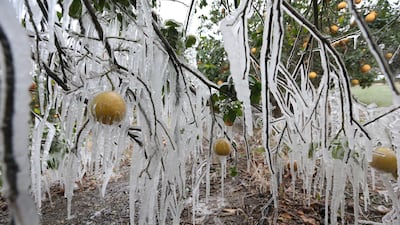The sudden drop in temperatures across 14 states in the US, including the country's energy capital, Texas, may have longer-term implications for energy transition in the world's largest fossil-fuel producer.
Severe storms blanketed the southern state under snow, with temperatures falling as low as -8 degrees Celsius (17.6 Fahrenheit), equivalent to the weather in the country's northern-most state of Alaska.
More than 4.3 million households and businesses faced an electricity blackout, while nearly 400,000 homes in states stretching from Louisiana in the south-east to Ohio in the mid-west were also cut off from power.
The disruption of natural gas exports to Mexico, which lies to the south of the US, took power stations offline, leaving more than 4.7 million homes without power.
Critical energy infrastructure including oil and gas, as well as wind, which accounts for 25 per cent of supply in the winter, failed to generate electricity as equipment froze in the Arctic-like temperatures.
Wind turbines stopped rotating as the equipment was not designed to withstand severe climatic conditions such as those witnessed across nearly a third of the US.
The severe weather event could throw a major spanner in the works of the US's ongoing energy transition, the world's largest producer of oil and gas, according to Stephen Innes, chief global market strategist at Axi.
"I think we're going to see more of a pivot back to shale from an investment perspective," he said.
Around 1 million barrels per day of US production has been taken offline, with the benchmark West Texas Intermediate surging above $60 per barrel for the first time in a year.
The production currently offline could return in "two weeks" with the energy industry likely to make upgrades to infrastructure and capitalise on the recent price rallies, Mr Innes said.
A resurgence of shale on the back of scepticism over the endurance of renewable energy in such conditions is likely to deter the US's ongoing transition plans.
President Joe Biden's administration plans to push for a $2 trillion clean energy investment agenda, nudged by the green elements of the Democratic caucus.
Mr Biden, who reversed major changes to the US energy policy such as rejoining the Paris Agreement upon inauguration and halting drilling across federal lands, is likely to face pushback from the energy industry as well as politicians from within his own Democratic party.
The deep freeze across the US is likely to energise the oil industry to lobby on the premise of the indispensability of fossil fuels in dire climatic conditions.
Apart from wind, the icy temperatures also shut down natural gas, coal and nuclear power plants, which together make up around two thirds of the energy mix in Texas.
Questions are being raised about the operability of wind and solar under such conditions, even as the scenario sheds light on the change in weather patterns due to climate change.
"Climate deniers are unlikely to be shaken by the recent events, probably arguing that the world should be getting hotter, and not snowing outside," said Jeffrey Halley, senior market analyst, Asia Pacific at Oanda.
"That misses the point that climate change will mean parts of the world will get hotter, and some much colder. Meaningful acceptance of climate change will need to come from the top down, which starts in Washington DC," he added.
Mr Biden will have a long road ahead pushing for meaningful clean energy investments even as he tries to pass a contested $1.9tn stimulus package, Mr Halley said.
Mr Biden's presidential campaign pledge of a $2tn green agenda may not translate into reality, he added.
With 13 people dead across the US, the deep freeze may well be a reminder to the White House to push for much-needed upgrades in power generation systems.
"The blackouts in the central US and Mexico are not solely due to wind turbines freezing," Mr Halley said, adding, "[its] rather a cascading series of failures across the whole energy value chain."




























